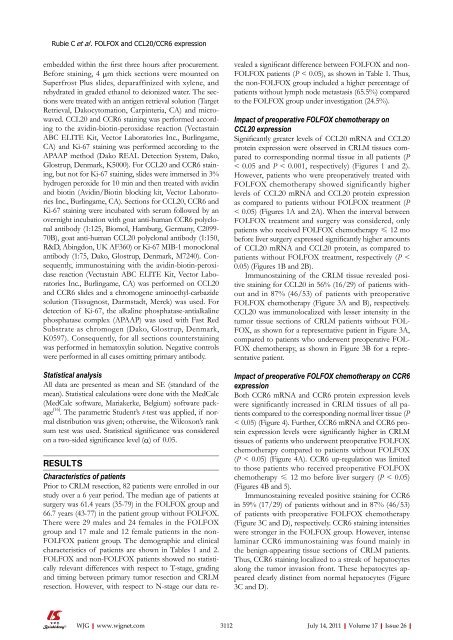26 - World Journal of Gastroenterology
26 - World Journal of Gastroenterology
26 - World Journal of Gastroenterology
Create successful ePaper yourself
Turn your PDF publications into a flip-book with our unique Google optimized e-Paper software.
Rubie C et al . FOLFOX and CCL20/CCR6 expression<br />
embedded within the first three hours after procurement.<br />
Before staining, 4 μm thick sections were mounted on<br />
Superfrost Plus slides, deparaffinized with xylene, and<br />
rehydrated in graded ethanol to deionized water. The sections<br />
were treated with an antigen retrieval solution (Target<br />
Retrieval, Dakocytomation, Carpinteria, CA) and microwaved.<br />
CCL20 and CCR6 staining was performed according<br />
to the avidin-biotin-peroxidase reaction (Vectastain<br />
ABC ELITE Kit, Vector Laboratories Inc., Burlingame,<br />
CA) and Ki-67 staining was performed according to the<br />
APAAP method (Dako REAL Detection System, Dako,<br />
Glostrup, Denmark, K5000). For CCL20 and CCR6 staining,<br />
but not for Ki-67 staining, slides were immersed in 3%<br />
hydrogen peroxide for 10 min and then treated with avidin<br />
and biotin (Avidin/Biotin blocking kit, Vector Laboratories<br />
Inc., Burlingame, CA). Sections for CCL20, CCR6 and<br />
Ki-67 staining were incubated with serum followed by an<br />
overnight incubation with goat anti-human CCR6 polyclonal<br />
antibody (1:125, Biomol, Hamburg, Germany, C2099-<br />
70B), goat anti-human CCL20 polyclonal antibody (1:150,<br />
R&D, Abingdon, UK AF360) or Ki-67 MIB-1 monoclonal<br />
antibody (1:75, Dako, Glostrup, Denmark, M7240). Consequently,<br />
immunostaining with the avidin-biotin-peroxidase<br />
reaction (Vectastain ABC ELITE Kit, Vector Laboratories<br />
Inc., Burlingame, CA) was performed on CCL20<br />
and CCR6 slides and a chromogene aminoethyl-carbazide<br />
solution (Tissugnost, Darmstadt, Merck) was used. For<br />
detection <strong>of</strong> Ki-67, the alkaline phosphatase-antialkaline<br />
phosphatase complex (APAAP) was used with Fast Red<br />
Substrate as chromogen (Dako, Glostrup, Denmark,<br />
K0597). Consequently, for all sections counterstaining<br />
was performed in hematoxylin solution. Negative controls<br />
were performed in all cases omitting primary antibody.<br />
Statistical analysis<br />
All data are presented as mean and SE (standard <strong>of</strong> the<br />
mean). Statistical calculations were done with the MedCalc<br />
(MedCalc s<strong>of</strong>tware, Mariakerke, Belgium) s<strong>of</strong>tware package<br />
[16] . The parametric Student’s t-test was applied, if normal<br />
distribution was given; otherwise, the Wilcoxon’s rank<br />
sum test was used. Statistical significance was considered<br />
on a two-sided significance level (α) <strong>of</strong> 0.05.<br />
RESULTS<br />
Characteristics <strong>of</strong> patients<br />
Prior to CRLM resection, 82 patients were enrolled in our<br />
study over a 6 year period. The median age <strong>of</strong> patients at<br />
surgery was 61.4 years (35-79) in the FOLFOX group and<br />
66.7 years (43-77) in the patient group without FOLFOX.<br />
There were 29 males and 24 females in the FOLFOX<br />
group and 17 male and 12 female patients in the non-<br />
FOLFOX patient group. The demographic and clinical<br />
characteristics <strong>of</strong> patients are shown in Tables 1 and 2.<br />
FOLFOX and non-FOLFOX patients showed no statistically<br />
relevant differences with respect to T-stage, grading<br />
and timing between primary tumor resection and CRLM<br />
resection. However, with respect to N-stage our data re-<br />
WJG|www.wjgnet.com<br />
vealed a significant difference between FOLFOX and non-<br />
FOLFOX patients (P < 0.05), as shown in Table 1. Thus,<br />
the non-FOLFOX group included a higher percentage <strong>of</strong><br />
patients without lymph node metastasis (65.5%) compared<br />
to the FOLFOX group under investigation (24.5%).<br />
Impact <strong>of</strong> preoperative FOLFOX chemotherapy on<br />
CCL20 expression<br />
Significantly greater levels <strong>of</strong> CCL20 mRNA and CCL20<br />
protein expression were observed in CRLM tissues compared<br />
to corresponding normal tissue in all patients (P<br />
< 0.05 and P < 0.001, respectively) (Figures 1 and 2).<br />
However, patients who were preoperatively treated with<br />
FOLFOX chemotherapy showed significantly higher<br />
levels <strong>of</strong> CCL20 mRNA and CCL20 protein expression<br />
as compared to patients without FOLFOX treatment (P<br />
< 0.05) (Figures 1A and 2A). When the interval between<br />
FOLFOX treatment and surgery was considered, only<br />
patients who received FOLFOX chemotherapy ≤ 12 mo<br />
before liver surgery expressed significantly higher amounts<br />
<strong>of</strong> CCL20 mRNA and CCL20 protein, as compared to<br />
patients without FOLFOX treatment, respectively (P <<br />
0.05) (Figures 1B and 2B).<br />
Immunostaining <strong>of</strong> the CRLM tissue revealed positive<br />
staining for CCL20 in 56% (16/29) <strong>of</strong> patients without<br />
and in 87% (46/53) <strong>of</strong> patients with preoperative<br />
FOLFOX chemotherapy (Figure 3A and B), respectively.<br />
CCL20 was immunolocalized with lesser intensity in the<br />
tumor tissue sections <strong>of</strong> CRLM patients without FOL-<br />
FOX, as shown for a representative patient in Figure 3A,<br />
compared to patients who underwent preoperative FOL-<br />
FOX chemotherapy, as shown in Figure 3B for a representative<br />
patient.<br />
Impact <strong>of</strong> preoperative FOLFOX chemotherapy on CCR6<br />
expression<br />
Both CCR6 mRNA and CCR6 protein expression levels<br />
were significantly increased in CRLM tissues <strong>of</strong> all patients<br />
compared to the corresponding normal liver tissue (P<br />
< 0.05) (Figure 4). Further, CCR6 mRNA and CCR6 protein<br />
expression levels were significantly higher in CRLM<br />
tissues <strong>of</strong> patients who underwent preoperative FOLFOX<br />
chemotherapy compared to patients without FOLFOX<br />
(P < 0.05) (Figure 4A). CCR6 up-regulation was limited<br />
to those patients who received preoperative FOLFOX<br />
chemotherapy ≤ 12 mo before liver surgery (P < 0.05)<br />
(Figures 4B and 5).<br />
Immunostaining revealed positive staining for CCR6<br />
in 59% (17/29) <strong>of</strong> patients without and in 87% (46/53)<br />
<strong>of</strong> patients with preoperative FOLFOX chemotherapy<br />
(Figure 3C and D), respectively. CCR6 staining intensities<br />
were stronger in the FOLFOX group. However, intense<br />
laminar CCR6 immunostaining was found mainly in<br />
the benign-appearing tissue sections <strong>of</strong> CRLM patients.<br />
Thus, CCR6 staining localized to a streak <strong>of</strong> hepatocytes<br />
along the tumor invasion front. These hepatocytes appeared<br />
clearly distinct from normal hepatocytes (Figure<br />
3C and D).<br />
3112 July 14, 2011|Volume 17|Issue <strong>26</strong>|

















